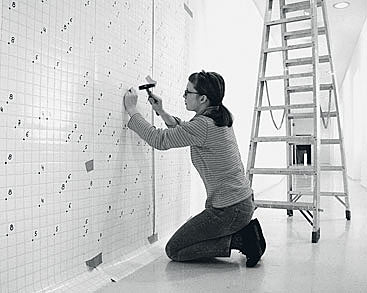
Born in 1970 in Conflans-Sainte-Honorine (FR)
Lives and works in Berlin (DE) and Paris (FR)

1994
Pattern, colored rawplugs
Dimensions variables
Year of Purchase: 1999
This ‘wall of rawplug’ extends over the entire surface of one wall of the exhibition space. The work is produced following a principle defined by the artist: place against a white wall a 60 × 60 cm template locating the holes to be drilled, procure the corresponding rawplug, of various diameters and colours – each diameter being a different colour – and then drill the holes. Copies of the template can be made and patiently used over and over again until the wall is riddled with rawplugs.
The reference to Sol LeWitt’s wall drawings is pretty obvious. The piece can be produced from an instruction leaflet, and its final physical form and dimensions will depend closely on where one chooses to place the work. In line with the Statements of Lawrence Weiner, the work ‘can be produced’ or not. There are aesthetic concerns as well: attention is given to even spacing when using the template, while the bright colours and variety of wall-plug diameters testify to the decorative intention. The white wall, another requirement laid down by Mathieu Mercier, confirms this aim: the myriad of points thus activated is not to be upstaged by possible competition from a pattern or preexisting colour. The wall of rawplug is a highly pragmatic affair: a rawplug is a practical item, particularly useful for hanging an artwork or anything else. The wall is designated as being a work, but it rather seems on standby, set with the hanging process only half-finished; in addition to its decorative dimension, the wall draws our attention to its possible function in the context of presenting artworks. In this sense, it forgoes self-sufficiency, as if awaiting the actual work itself, the possibility of hanging works being left to the owner’s initiative.
The mundane activity of do-it-yourself and interior decoration, added to a direct allusion to the artist’s environment – the world of art and its references – is typical of Mathieu Mercier’s work. As for other works, the utilitarian dimension, the DIY mentality, the possible reproduction of the work (the wall of rawplug can be exhibited in several places at once) go against the categories long used to define the artwork. These elements refer back to domestic practices and decoration as it applies to the greatest number, and carry the mechanisms of production and industrial consumption into the field of art.
Over and above the ambiguity which this Mur de chevilles introduces between the utilitarian and aesthetic functions, it offers discreet criticism of contemporary living conditions, midway between work and leisure, oscillating between a legitimate desire to be different and the relentless standardization that threatens our interiors. The parallel drawn with the conventions and practices of contemporary art only amplifies the significance of it.
Corinne Charpentier